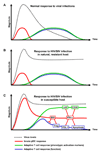Chronic innate immune activation as a cause of HIV-1 immunopathogenesis
- PMID: 17916442
- PMCID: PMC2275778
- DOI: 10.1016/j.clim.2007.08.015
Chronic innate immune activation as a cause of HIV-1 immunopathogenesis
Abstract
Human immunodeficiency virus (HIV)-1 infection causes progressive impairment of the immune system in humans, characterized by depletion of CD4 T cells and loss of T cell function. Increased markers of T cell activation and lymphoid hyperplasia suggest that chronic T cell activation persists in immunocompromised hosts, and contributes to the exhaustion of immune functions. Here we propose a revision of this hypothesis, in which we suggest that chronic activation of innate immunity may negatively affect adaptive T cell-mediated responses. We hypothesize that constant exposure of the effector cells of innate immunity to HIV results in their chronic hyperactivation, with deleterious effects on T cells. In particular, plasmacytoid dendritic cells (pDC) may be highly susceptible to HIV-induced activation due to its interaction with the cellular receptor CD4, expressed by pDC. Subsequent production of type I interferon and indoleamine 2,3-dioxygenase may exert suppressive and cytotoxic effects on T cells.
Figures

References
-
- Letvin NL, Walker BD. Immunopathogenesis and immunotherapy in AIDS virus infections. Nat Med. 2003;9:861–866. - PubMed
-
- Paiardini M, Cervasi B, Dunham R, Sumpter B, Radziewicz H, Silvestri G. Cell-cycle dysregulation in the immunopathogenesis of AIDS. Immunol Res. 2004;29:253–268. - PubMed
-
- Picker LJ. Immunopathogenesis of acute AIDS virus infection. Curr Opin Immunol. 2006;18:399–405. - PubMed
-
- Brenchley JM, Price DA, Douek DC. HIV disease: fallout from a mucosal catastrophe? Nat Immunol. 2006;7:235–239. - PubMed
-
- Derdeyn CA, Silvestri G. Viral and host factors in the pathogenesis of HIV infection. Curr Opin Immunol. 2005;17:366–373. - PubMed
Publication types
MeSH terms
Grants and funding
LinkOut - more resources
Full Text Sources
Other Literature Sources
Medical
Research Materials

